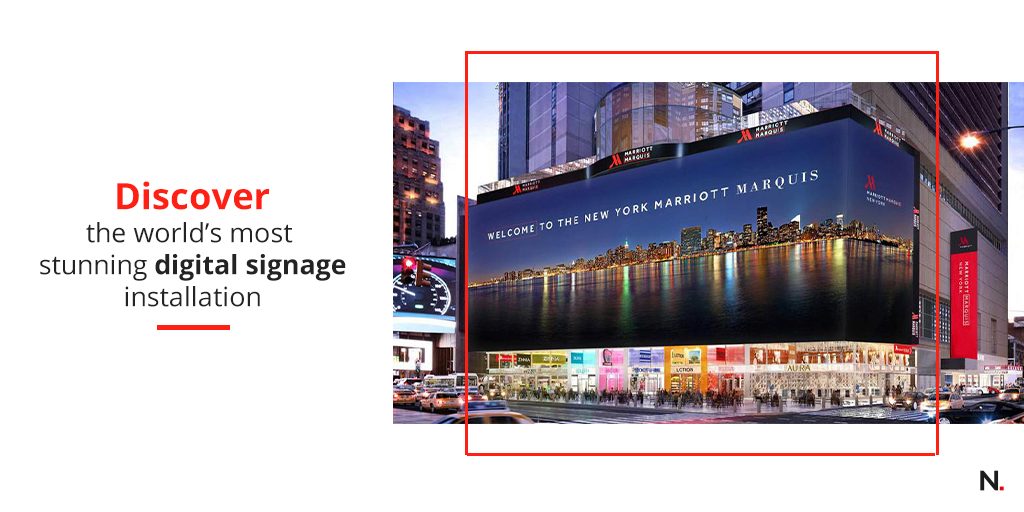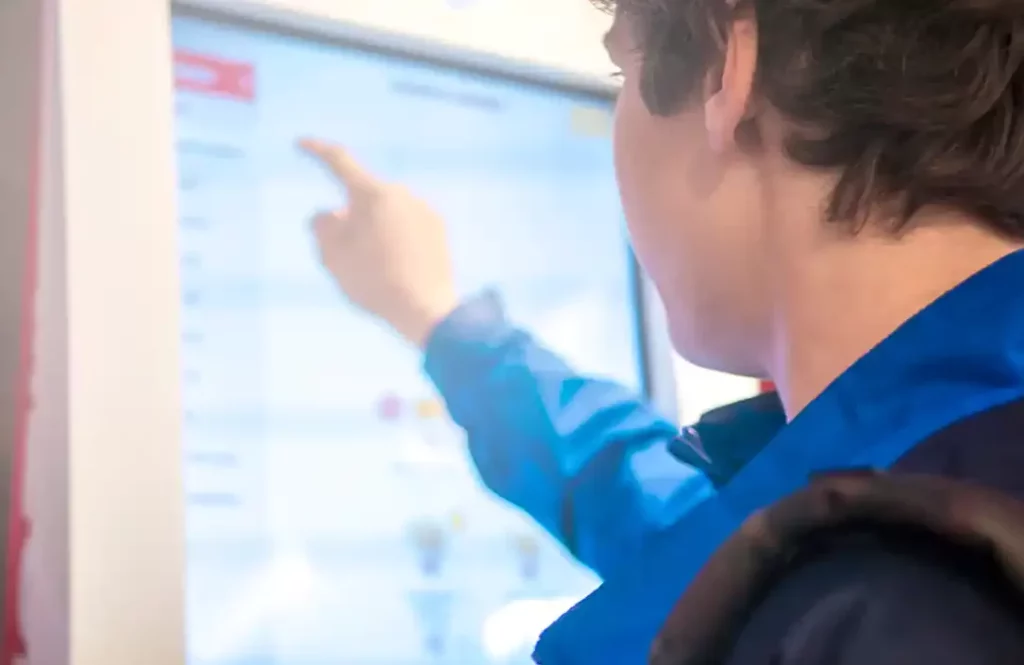How Digital Displays Work?
Digital displays are essentially flat panel screens that rely on different technologies to present multimedia content to an audience. The most common are LCD screens which use liquid crystal cells to screen content and LED displays which are based on Light Emitting Diode technology. Digital displays on their own can’t do much. They need some type of standalone player hardware and digital signage software that can render content for them.
A larger size doesn’t mean high-quality
Digital displays come in many sizes that vary from one manufacturer to another. What’s important to note is the physical size of a screen is quite often independent of the image resolution it can support. So, selecting a bigger screen doesn’t guarantee your content will be sharper or better. Besides physical size, the display’s resolution is one of the most crucial factors to consider when selecting a digital signage display.
Before making your choice, always consider the distance between the viewer and the display’s final location. The further the viewer in relation to the display, the lower the resolution (and the larger the display) you will need. If the viewer is close to the display, pick a screen that supports a higher resolution. Here’s why. Fine details can’t be seen from a distance. Therefore, it makes little sense to spend a lot of money on high-resolution displays if you are planning to install them far from the audience. And it’s not just horizontal distance. You need to consider mounting height as well.
There are many screen size calculators you can find online that you can use to determine the right size screen for the location. These calculators can be extremely useful and they are a simple google search away.

Popular image resolutions supported
Here are some of the more popular video resolutions supported by digital displays: HD (720p), Full HD (1080p), and UHD (4K) powers by Navori Android player device Stix or a Windows PC. You can purchase screens in many different sizes that will support many, if not all these resolutions.
However, it’s important to select standalone player hardware, digital screen board and digital signage software that will also support the target resolution. Today, HD and full HD support can be expected and there are more UHD-capable media players coming onto the market every month. Soon, we’ll be looking at 8K displays but you should always remember the audience will need to be extremely close to benefit from such a high-resolution image.
Screen Orientation
It’s a good idea to ask your screen vendor if the backlighting is compatible with more than one mounting orientation. For example, some displays position the background LEDs in a way that favors one orientation over the other (usually, landscape). If you plan to install displays in a vertical (portrait) orientation, make sure the display’s background lighting provides an even coverage so there are no hot spots or shadows. Professional grade displays are designed in such a way the backlight will always be even, regardless of the screen orientation. Still, it’s important you confirm this prior to installation.
Outdoor applications and high-brightness screens
Another important point to consider is luminosity. Most LED signage screens are backlit meaning the light source is located behind the image. This is great for interior applications where there are no bright lights that can affect the display.
There are special types of digital displays that are designed in such a way that they remain visible, even under direct sunlight. However, these displays tend to be very expensive, so they are usually relegated to high-end projects that can warrant investment. High luminosity displays can be used in storefront displays where they remain protected from the elements.
Exterior displays can use standard LED screens protected by weatherproof housing or LED panels that come in very large sizes. These panels offer a relatively low resolution, so they are mostly used for LED billboard applications. This works quite well because potential viewers tend to be located at a fair distance from the billboards.
Most LED billboards support low image resolutions so you may need a special video card that can match the display’s capabilities. It’s important to use standalone player software that can adapt to the widest possible range of resolutions. Otherwise, you may not be able to show the content as intended.
Ruggedized displays
There are many locations that are toxic to most consumers and professional-grade digital displays. These are often found in restaurants, garages, industrial shops, factories, and many other environments that are hostile to electronic devices. The enemies are moisture, steam, grease, impact, vibration, extreme heat, and cold. Digital displays destined for these applications must be able to operate outside normal parameters for extended periods without failing.
This is where we find hardware originally designed for military applications. There are displays that feature ballistic-resistant glass for impact protection or all-weather digital screen enclosures that are completely waterproof. Some screen enclosures include heating elements or air-conditioning systems to protect from cold and warm weather.
There are screen enclosures that can be locked to protect the contents from tampering and others that can be mounted near restaurant equipment where they are exposed to high moisture levels and heat. If you can think of an application, chances are there is a custom screen or enclosure that was already designed for it.
Interactive displays
Digital displays are also available as touchscreens. These displays are used in interactive applications, such as wayfinding or information kiosks. Touchscreens use various technologies to detect interactivity. Most touchscreens come equipped with a touch-sensitive layer right out of the factory. There are also kits available that let you retrofit existing “passive” displays to make them touch-enabled.
Touchscreen technologies have benefited greatly from the smartphone and tablet markets and there are many interactive digital signage projects that run on tablets. Tablets offer many advantages because the standalone player hardware is built right into the device
More recently, we’ve seen sensors installed above and below digital displays. These sensors are meant to detect a person’s motion instead of touch. Any sensor or camera can by used extensively in custom interactive applications.

Smart displays
The latest trend in digital signage is the smart display. These displays are also called “System on Chip” or SoC because they include an entire computer on a single piece of silicon. With SoC displays, the standalone player hardware is embedded behind the glass, right inside the screen frame. Smart displays have more in common with tablets than your run-of-the-mill “dumb” display. They are gaining in popularity because they are less expensive and easier to deploy than similar unbundled components.
Your traditional digital signage deployment requires many parts. There is the display, the standalone player hardware, cabling (HDMI, USB, power…), and the standalone player software. With SoC displays, there are two components: the screen and the software. There is no external standalone player device to mount behind the display. No wires to connect and hide. You end up with a more professional installation that is less prone to theft or vandalism.
SoC displays used to be underpowered and difficult to manage because manufacturers were relying on proprietary operating systems. Newer generation SoC digital screen boards use the more ubiquitous Android (or Android-derived) operating systems, opening the market to many professional-grade digital signage solutions.

